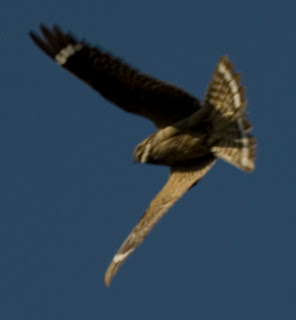I took a very leisurely trip to Cameron yesterday. I know migration is slowing to a trickle, but that trickle is still a huge volume of birds, and I think the chance to see one more Bay-breasted or Blackburnian Warbler before autumn by driving to Cameron instead of Canada is worth taking.
In the town of Holly Beach, the first birds that caught my eye were these Common Nighthawks:
I really like nighthawks. There's a lot still to learn about these birds, even on the ID front, so I take pictures like these and veg out in front of the computer studying patterns and feathers:
Someday I hope to crack that code. However, even from that picture, I think you can accurately age, sex, and identify this bird to species.
At Lighthouse, one of the first birds I saw was a Tropical-type Kingbird, and I realized shortly that there were two, so I spent most of the morning standing around watching them.
I also saw these flowers that I'd love an ID on:
And an Eastern Wood Pewee that's on its way north.
There was also this dragonfly that I can't remember the name of:
At Hackberry Ridge, there was still a bit of water left from last week's heavy rain, and this Least Tern was by the road in a shorebird pond.
The prickly pear was in beautiful flower, and this migrant male Ruby-throated hummer must've wondered what he was going to do with the huge blooms.
But he figured it out.
At Jetty Woods, there was a pair of Swainson's Hawks. I had some there during the breeding season last year, so I'd imagine nesting is likely.
On the way back home, I flushed another nighthawk from the roadside. It fluttered for a couple of feet, then landed, so I took a look.
I checked the spot where it had gotten up, and saw what I'd suspected:
From here on out, birding will be getting more predictable through the summer. However, even the predictable finds are amazing in their own right. Our native birds are worth sweating and swatting bugs to see. And if you're looking for something different, well, as they say, you have to do something different to see something different.
By the way, I didn't get a Blackburnian Warbler, but I did get a very dull female Bay-breasted.














































